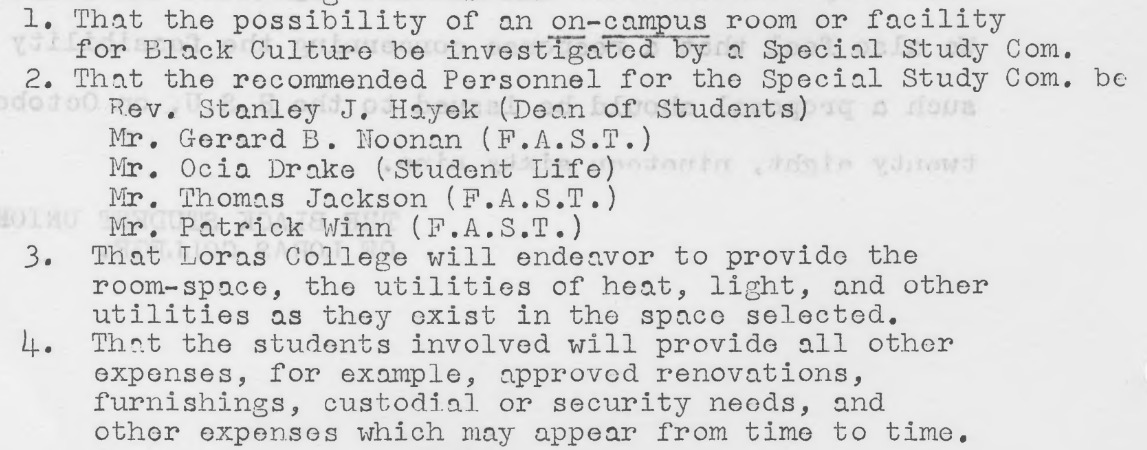The Quest for a Black Culture House
————————————————————————————————————————————————
Proposal and Initial Communications
————————————————————————————————————————————————
The members of Loras College's Black Student Union believed that a culture house would benefit the campus community at large. On October 14, 1969, the BSU presented a proposal for a Black Cultural House to the Student Life Committee.
With this goal in mind, the BSU laid out their plan to establish a Black Culture House at Loras College. They hoped that the United States Office of Equal Opportunity or the Economic Opportunity grant would help fund the project. They suggested that the house be located near the campus and that the college's Black counselor should be its moderator. They concluded, stating, "We, the Black Students of Loras College feel that the principle and philosophy of this proposal should be taken into deep consideration and be investigated thoroughly" (1).
On October 14, 1969, The Student Life Committee forwarded the culture house proposal to President Driscoll, asking that he "set up a committee to study the feasibility of a Black Cultural House and to make a progress report to the Black Students by October 28, 1969." Three days later, Driscoll presented the request to the Board of Regents during their annual meeting. The BSU later expressed frustration that President Driscoll did not set up an investigative committee before taking the proposal directly to the Board of Regents. In doing so, the BSU felt that the Regents were making an uninformed final decision before the feasibility of a culture house was ever explored.
On October 17, 1969, the Board of Regents meeting minutes stated:
In a position paper distributed by the student senate later that month, they stated, "The refusal of the off-campus location was due not only to the inability of the college to make a capital outlay, but also other groups have appealed for such privileges and were refused even if a capital outlay was not a factor." The BSU released a statement addressed to the campus body upon hearing the board's decision. They summarized the college's recent expenditures, and concluded that no students or members of the campus body have benefited from them. They reiterated that the culture house would "provide a cultural atmosphere for the enrichment of the White Student body as well as the increased knowledge of Black Students." They continued to explain the benefits to the whole Loras Community, providing seminars and workshops to increase general knowledge of the social climate (2).
The Board passed the matter to the Council of Administration for further consideration.
On October 23, 1969, the Council of Administration determined:
By taking their proposal directly to the Board of Regents, the students felt that the possibility of an off-campus building was off the table before the new investigating committee was ever appointed by the Council of Administration. On October 29, 1969, the students met with Driscoll to express this frustration. The BSU called the meeting a failure because "Msgr. Driscoll was reluctant to speak to all the black students at one time; They failed to get his reasons against an off-campus location; [and] He, in general, did not make his position clear" (1).
After this reply, the BSU began planning a sit-in at Henion Manor, an administrative building located just east of Loras College's campus. They explained, "The primary purpose of the occupancy was to make Msgr. Driscoll take a definite stand on the matter of the Black Cultural Center" (1).
Click purple resource titles to view online or make an appointment to visit the archive!
Cited Sources |


